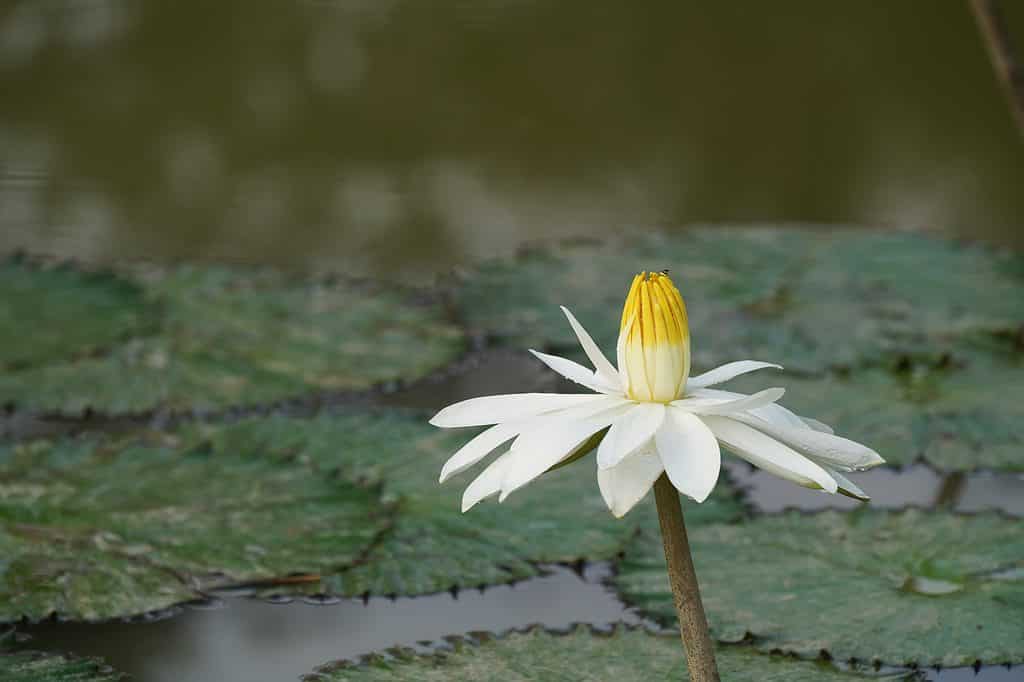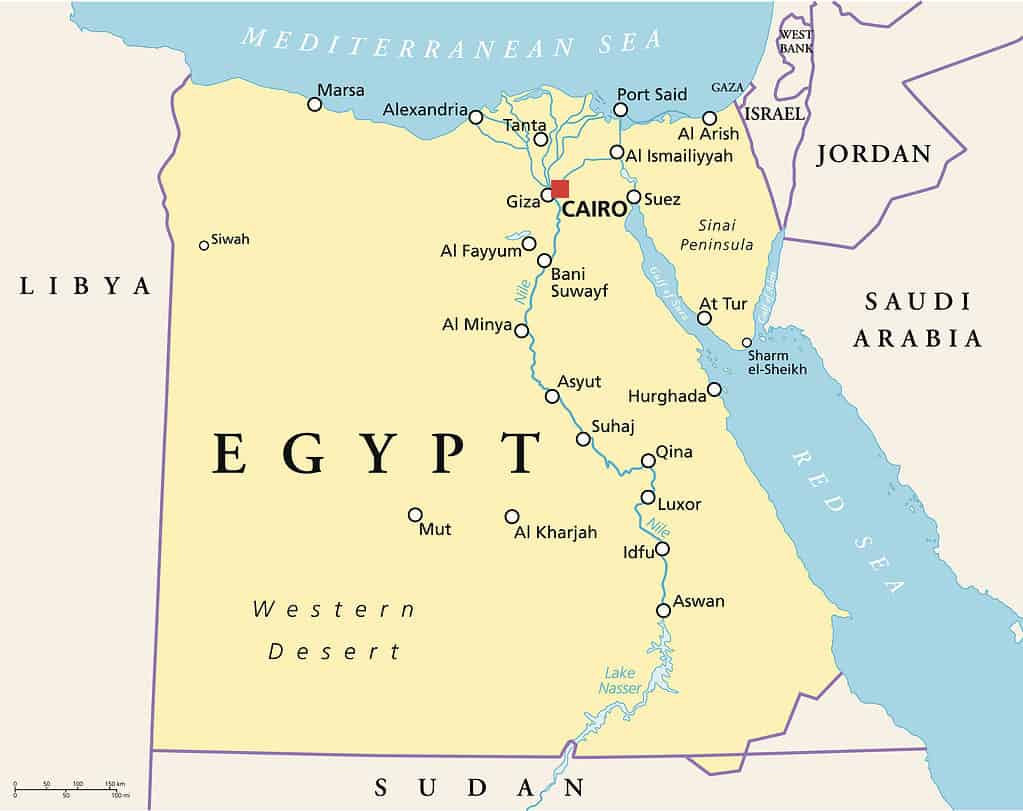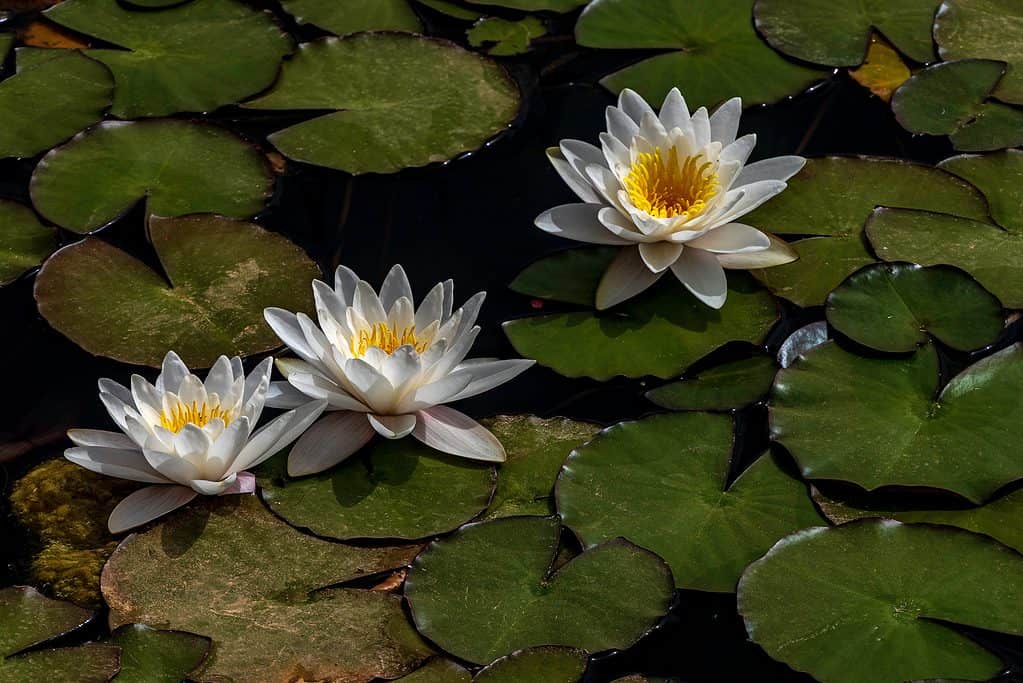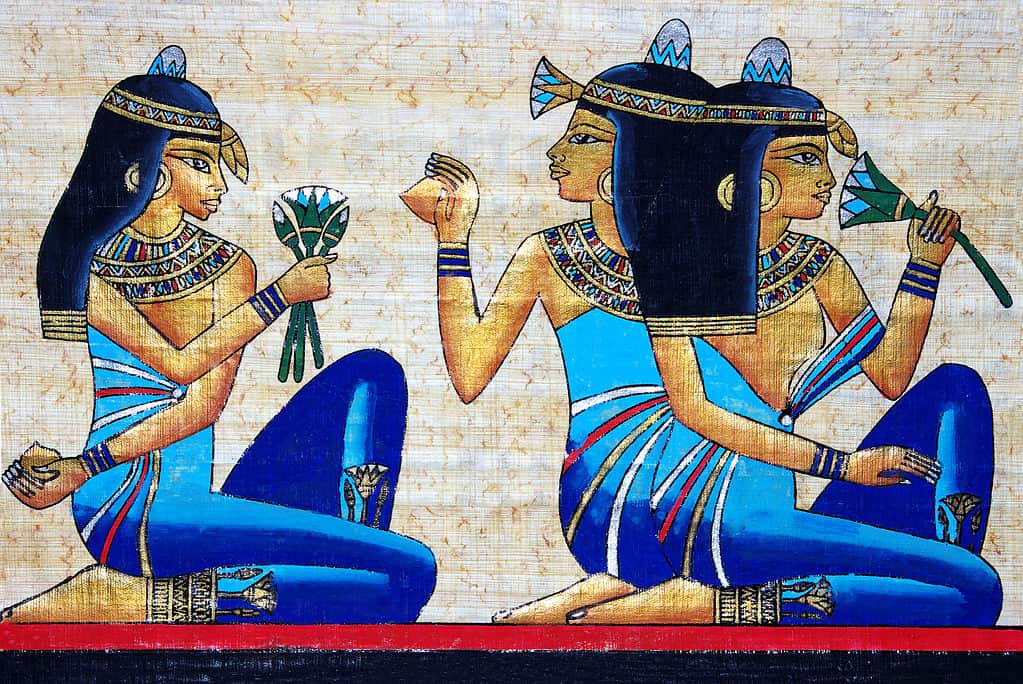Egypt is a country with a long and rich history, and plants have been an important part of that history. The Egyptian lotus (Nymphaea lotus) is the national flower of Egypt, symbolizing rebirth, fertility, eternity, and creation. Its roots are planted in the mud at the bottom of lakes or rivers while its flowers float on top of the water.

The national flower of Egypt is the Egyptian lotus.
©Doikanoy/Shutterstock.com
Geography of Egypt
Egypt is located in northeastern Africa, bordered by Libya to the west and Sudan to the south. The country has a population of over 99 million people. Egypt’s terrain consists mostly of a desert plateau with some areas of low-lying fertile land along the Nile River Valley and its delta. The eastern Sahara Desert covers most of Egypt’s land area, while there are also significant mountain ranges in the Sinai Peninsula and other parts of the country.
The climate in Egypt is hot and dry throughout most regions, with mild winters in some areas like Cairo. Temperatures can reach up to 104° Fahrenheit between June and August across much of lower Egypt. Temperatures become cooler as one moves further south into Upper Egypt or close to mountains like Mount Catherine near the Sinai Peninsula. Rainfall tends to be light and sporadic but increases dramatically around the Mediterranean coastlines (Alexandria).

Egypt is located in northeastern Africa, bordered by Libya to the west and Sudan to the south.
©iStock.com/PeterHermesFurian
People and Culture
The people of Egypt are incredibly diverse, with many different ethnicities and religions represented. Egyptians have a long history of cultural exchange that has resulted in influences from Ancient Greek, Roman, Arab and Ottoman cultures. The majority of the population is Muslim, although there is also a significant minority of Coptic Christians who are native to the region.
Egyptian culture has ancient roots dating back to pharaonic times when music, art, and literature were highly valued by society. Today this heritage continues through traditional folk dance performances as well as more modern forms, such as Baladi music and belly dancing which can be seen in clubs across Cairo.
Additionally, Egyptian cuisine is renowned for its unique flavors that often combine spices like cumin and coriander with aromatic herbs like parsley or mint. Street food vendors offer an array of delicious dishes ranging from kabobs to falafel sandwiches, while formal dining experiences often feature succulent seafood or kebabs cooked over open flame grills. No matter where you find yourself in Egypt, you’re sure to discover something new!
Plants of Egypt
Native plants in Egypt include species from various genera, such as Acacia, Eucalyptus, Tamarix, and Prosopis. These plants are hardy to drought-like conditions and extreme heat, making them perfect for desert regions and cultivated fields throughout the countryside. You can find various herbs like sagebrush, coriander, and fennel growing wild around much of Egypt.
In addition to the beautiful Egyptian lotus, many other native species of flowers can be found in Egypt. These include the bright red African daisy, the delicate desert rose, which is a type of hibiscus, and fragrant white jasmine. Other flowering plants, such as bougainvillea and oleander, also grow throughout Egypt.
The Nile Delta region is home to a variety of aquatic plants like water lilies, lotuses, and papyrus reeds. In contrast to its arid landscape, Egypt has an abundance of colorful wildflowers that fill both garden beds and roadsides during the summer months.
What is an Egyptian Lotus?
The Egyptian lotus is a beautiful and unique flower native to Egypt. It is a night-blooming perennial aquatic plant. It has a striking, bright white color with yellow stamens in the center. The petals of the lotus can range in size from small to large, depending on the species. Its leaves are round with serrated edges that often have white or gold highlights along them.
The blooms typically begin to appear during late spring and early summer months on aquatic plants such as ponds or riverside marshes, as well as fields and gardens near bodies of water that receive ample sunlight throughout the day. The Egyptian lotus is known for its ability to survive even when it’s submerged underwater. This quality allows it to be used as an ornamental plant for landscaping purposes both indoors and outdoors, adding beauty and visual interest wherever it’s planted!

The Egyptian lotus has a striking, bright white color with yellow stamens in the center.
©Emma Grimberg/Shutterstock.com
How to Grow an Egyptian Lotus
When planting the Egyptian lotus, it is best to do so in the spring, when temperatures are consistently over 70°F. Place the tubers in a small container filled with neutral or slightly acidic soil and submerge it ten or more inches under the water.
They will grow 8-12 inches tall and perform best when exposed to full sun for most of the day. However, during peak heat hours (over 100°F), they should receive partial shade and protection from strong winds. It is important to feed them aquatic fertilizer every 2-3 weeks and deadhead any yellowing leaves regularly. With these tips in mind, you can successfully grow an Egyptian lotus!
Other Uses For Egyptian Lotus
In addition to its ornamental and symbolic value, the Egyptian lotus provides a variety of uses for people living in Africa. The rhizomes and tubers contain a significant amount of starch which can be boiled, roasted, or ground into flour after drying. People may also use young fruits as a salad ingredient. Even more useful is the fact that both the tubers and seeds are commonly used as famine food in India due to their ability to provide much-needed sustenance during times of food shortages.
The ancient Egyptians were highly creative in finding ways to use Egyptian lotus. In addition to extracting perfume from its petals, they used it as a symbol of rebirth and eternal life, weaving it into funerary garlands for deceased loved ones. They also offered white lotus flowers in temples as offerings to their gods and goddesses. Women wore them as adornment, often braiding them into their hair or using them as part of jewelry pieces such as necklaces and anklets. The flower continues to be appreciated today both for its beauty and powerful symbolism.
Lotus Flower Myths
The ancient Egyptians believed that before life, nothing existed but a vast gray sea. Then, the lotus flower emerged from the water, bringing light and fragrance to the world. This lotus was thought to be a symbol of the sun, as it blooms early every morning and resembles rays of sunlight.
Ancient people nicknamed the lotus the Redolent flower. It was believed to contain the soul of the god of the sun, Ra, and that those who had passed away could use one of the spells in the Book of the Dead to transform into a lotus flower. Additionally, the lotus was used as a political symbol for upper Egypt and can be seen in various temples in that region.
In Egyptian mythology, Horus (god of kingship and sky) was occasionally shown in art as a naked boy perched on a lotus with his mom. The lotus was one of the first capital motifs in Egypt. Women often wore talismans around their necks during labor and childbirth that depicted Heqet (goddess of fertility) as a frog sitting inside a lotus. The white lotus represents 1,000 in Egyptian numerals and has its own hieroglyph.

The lotus flower has been a valuable part of Egyptian history and mythology.
©leoks/Shutterstock.com
Is Egyptian Lotus Beneficial to Wildlife?
The Egyptian lotus serves as a beneficial habitat for wildlife, such as fish, young waterfowl, and marsh birds. The stems and leaves of the Egyptian lotus provide much-needed shade to these animals while also limiting the abundance of submersed aquatic plants in its vicinity. This helps to create a balanced ecosystem where both animals and plants can thrive without competing with each other for resources.
Wildlife of Egypt
Egypt is home to a wide range of wild animals, including mammals like African wildcats, striped hyenas, and golden jackals. You can see reptiles such as crocodiles and cobras, as well as birds like storks and vultures. Amphibians like frogs and toads are also present, and there are many types of fish like catfish and tilapia.
Additionally, Egypt’s landscape is filled with various species of invertebrates, including locusts, beetles, butterflies, and moths. It not only provides a home for a variety of wildlife within its borders but also serves as a migratory route for many animals from Europe or Africa, making it a great destination for nature enthusiasts.
Up Next
- The Flag of Egypt: History, Meaning, and Symbolism
- Discover the 3 Most Populated Cities in Egypt
- The 10 Best Books About Egyptian Mythology — Reviewed and Ranked
The photo featured at the top of this post is © guentermanaus/Shutterstock.com
Thank you for reading! Have some feedback for us? Contact the AZ Animals editorial team.






